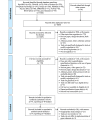The Effects of Gamification on Computerized Cognitive Training: Systematic Review and Meta-Analysis
- PMID: 32773374
- PMCID: PMC7445616
- DOI: 10.2196/18644
The Effects of Gamification on Computerized Cognitive Training: Systematic Review and Meta-Analysis
Abstract
Background: There has been a growing interest in the application of gamification (ie, the use of game elements) to computerized cognitive training. The introduction of targeted gamification features to such tasks may increase motivation and engagement as well as improve intervention effects. However, it is possible that game elements can also have adverse effects on cognitive training (eg, be a distraction), which can outweigh their potential motivational benefits. So far, little is known about the effectiveness of such applications.
Objective: This study aims to conduct a systematic review and meta-analysis to investigate the effect of gamification on process outcomes (eg, motivation) and on changes in the training domain (eg, cognition), as well as to explore the role of potential moderators.
Methods: We searched PsycINFO, Cumulative Index to Nursing and Allied Health Literature, ProQuest Psychology, Web of Science, Scopus, PubMed, Science Direct, Excerpta Medica dataBASE, Institute of Electrical and Electronics Engineers Xplore, Association for Computing Machinery, and a range of gray-area literature databases. The searches included papers published between 2008 and 2018. Meta-analyses were performed using a random-effects model.
Results: The systematic review identified 49 studies, of which 9 randomized controlled trials were included in the meta-analysis. The results of the review indicated that research in this context is still developing and lacks well-controlled empirical studies. Gamification in cognitive training is applied to a large range of age groups and audiences and is mostly delivered at a research site through computers. Rewards and feedback continue to dominate the gamification landscape, whereas social-oriented features (eg, competition) are underused. The meta-analyses showed that gamified training tasks were more motivating/engaging (Hedges g=0.72) and more demanding/difficult (Hedges g=-0.52) than non- or less-gamified tasks, whereas no effects on the training domain were found. Furthermore, no variables moderated the impact of gamified training tasks. However, meta-analytic findings were limited due to a small number of studies.
Conclusions: Overall, this review provides an overview of the existing research in the domain and provides evidence for the effectiveness of gamification in improving motivation/engagement in the context of cognitive training. We discuss the shortcomings in the current literature and provide recommendations for future research.
Keywords: cognition; gamification; health; meta-analysis; systematic review.
©Julie F Vermeir, Melanie J White, Daniel Johnson, Geert Crombez, Dimitri M L Van Ryckeghem. Originally published in JMIR Serious Games (http://games.jmir.org), 10.08.2020.
Conflict of interest statement
Conflicts of Interest: None declared.
Figures






Similar articles
-
Gamification of Cognitive Assessment and Cognitive Training: A Systematic Review of Applications and Efficacy.JMIR Serious Games. 2016 Jul 15;4(2):e11. doi: 10.2196/games.5888. JMIR Serious Games. 2016. PMID: 27421244 Free PMC article.
-
Gamification in Apps and Technologies for Improving Mental Health and Well-Being: Systematic Review.JMIR Ment Health. 2019 Jun 26;6(6):e13717. doi: 10.2196/13717. JMIR Ment Health. 2019. PMID: 31244479 Free PMC article.
-
A Gamification Framework for Cognitive Assessment and Cognitive Training: Qualitative Study.JMIR Serious Games. 2021 May 18;9(2):e21900. doi: 10.2196/21900. JMIR Serious Games. 2021. PMID: 33819164 Free PMC article.
-
Gamified Cognitive Bias Modification Interventions for Psychiatric Disorders: Review.JMIR Ment Health. 2018 Oct 25;5(4):e11640. doi: 10.2196/11640. JMIR Ment Health. 2018. PMID: 30361194 Free PMC article. Review.
-
Gamification in Mobile Apps for Children With Disabilities: Scoping Review.JMIR Serious Games. 2024 Sep 6;12:e49029. doi: 10.2196/49029. JMIR Serious Games. 2024. PMID: 39240675 Free PMC article.
Cited by
-
A randomized clinical trial to evaluate feasibility, tolerability, and preliminary target engagement for a novel executive working memory training in adolescents with ADHD.Behav Res Ther. 2024 Oct;181:104615. doi: 10.1016/j.brat.2024.104615. Epub 2024 Aug 19. Behav Res Ther. 2024. PMID: 39173523 Clinical Trial.
-
Preliminary evaluation of a gamified smartphone intervention (O2O-PEP) for enhancing HIV post-exposure prophylaxis uptake in men who have sex with men: pilot feasibility study.BMC Public Health. 2025 Apr 25;25(1):1539. doi: 10.1186/s12889-025-22818-w. BMC Public Health. 2025. PMID: 40281536 Free PMC article.
-
Effectiveness of remote gamification pulmonary rehabilitation intervention based on the health action process approach theory in older adults with chronic obstructive pulmonary disease: a pilot randomized controlled trial.Front Med (Lausanne). 2025 Jun 19;12:1576256. doi: 10.3389/fmed.2025.1576256. eCollection 2025. Front Med (Lausanne). 2025. PMID: 40612580 Free PMC article.
-
Usefulness of Digital Game-Based Learning in Nursing and Occupational Therapy Degrees: A Comparative Study at the University of Burgos.Int J Environ Res Public Health. 2021 Nov 9;18(22):11757. doi: 10.3390/ijerph182211757. Int J Environ Res Public Health. 2021. PMID: 34831516 Free PMC article.
-
A Smartphone-Gamified Virtual Reality Exposure Therapy Augmented With Biofeedback for Ailurophobia: Development and Evaluation Study.JMIR Serious Games. 2024 Mar 6;12:e34535. doi: 10.2196/34535. JMIR Serious Games. 2024. PMID: 38446522 Free PMC article.
References
-
- Harvey PD, McGurk SR, Mahncke H, Wykes T. Controversies in computerized cognitive training. Biol Psychiatry Cogn Neurosci Neuroimaging. 2018 Nov;3(11):907–15. doi: 10.1016/j.bpsc.2018.06.008. https://linkinghub.elsevier.com/retrieve/pii/S2451-9022(18)30159-9 - DOI - PubMed
-
- Lampit A, Hallock H, Valenzuela M. Computerized cognitive training in cognitively healthy older adults: a systematic review and meta-analysis of effect modifiers. PLoS Med. 2014 Nov;11(11):e1001756. doi: 10.1371/journal.pmed.1001756. http://dx.plos.org/10.1371/journal.pmed.1001756 - DOI - DOI - PMC - PubMed
-
- Kueider AM, Parisi JM, Gross AL, Rebok GW. Computerized cognitive training with older adults: a systematic review. PLoS One. 2012;7(7):e40588. doi: 10.1371/journal.pone.0040588. http://dx.plos.org/10.1371/journal.pone.0040588 - DOI - DOI - PMC - PubMed
-
- Beard C, Weisberg RB, Primack J. Socially anxious primary care patients' attitudes toward cognitive bias modification (CBM): a qualitative study. Behav Cogn Psychother. 2012 Oct;40(5):618–33. doi: 10.1017/S1352465811000671. http://europepmc.org/abstract/MED/22127022 - DOI - PMC - PubMed
-
- Kuckertz JM, Schofield CA, Clerkin EM, Primack J, Boettcher H, Weisberg RB, Amir N, Beard C. Attentional bias modification for social anxiety disorder: what do patients think and why does it matter? Behav Cogn Psychother. 2019 Jan;47(1):16–38. doi: 10.1017/S1352465818000231. http://europepmc.org/abstract/MED/29729676 - DOI - PMC - PubMed
LinkOut - more resources
Full Text Sources

